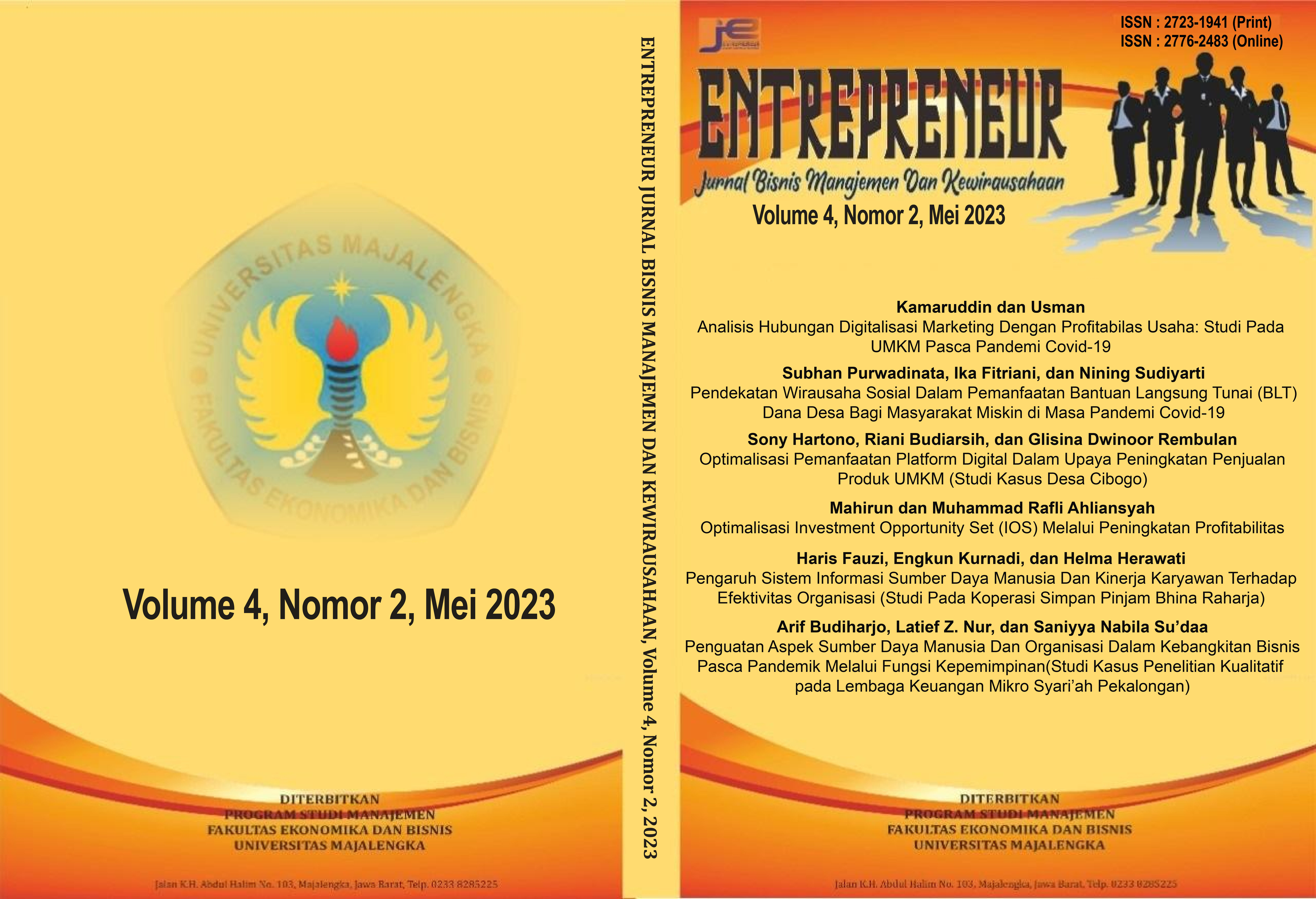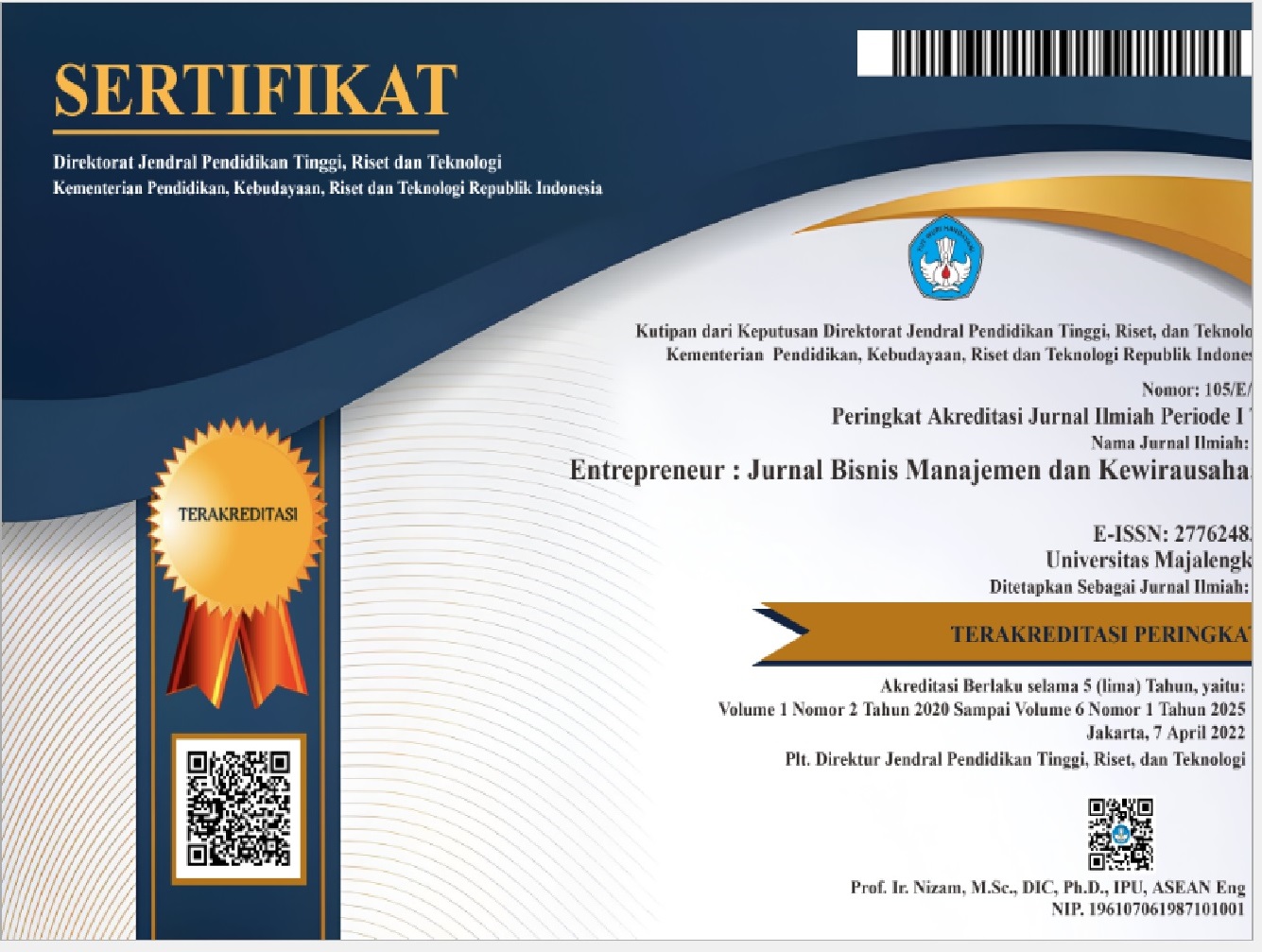A Analysis of Economic Impacts on Community Welfare in the Whale Shark Tourism Coastal Area, Labuhan Jambu Village, Sumbawa Regency
Economic Impact, Community Welfare
DOI:
https://doi.org/10.31949/entrepreneur.v4i2.4449Abstract
This study aims to analyze the economic impact on the welfare of the community around the Whale Shark area in the village of Labuhan Jambu. The current condition of the movement of the tourism industry in Labuhan Jambu Village is still not optimal. In addition to weak promotion, there are limited tourism support facilities and limited quality of human resources in managing tourism. The research method uses a quantitative descriptive approach. Source of data consists of secondary data and primary data. Data collection techniques are questionnaires, observation and documentation. The data analysis technique in this study uses structural equation modeling analysis. The results of the study indicate that there is no direct influence felt by the community as a whole from the existence of Whale Shark ecotourism on the community's economy and the welfare of the surrounding community. The direct influence is only felt by chart owners and operators of Whale Shark ecotourism, that chart owners and operators who deal directly with tourists who visit Whale Shark tours in the village of Labuhan Jambu. For tourists who rarely go ashore, the route used is the sea route. The tourists only stop for 1 to 2 hours to see the Whale Shark ecotourism, after which the tourists go straight to the next tourist spot, namely Komodo Island. This makes the community, especially business actors, not get a significant impact from Whale Shark ecotourism.
Keywords:
Economic Impact, Community WelfareDownloads
References
Azizurrohman, M., Habibi, P., Luh, Ni, Widyanti, S., Isdarmanto, Gambiro, H., Yamin, A., Kanzul Fikri Majid, Subari, S., & Anwar, A. (2021). Strategi Pengembangan Wisata Minat Khusus Hiu Paus Labuan Jambu Sumbawa. Jurnal Ilmiah Mandala Education, 8(1), 1–196.
Djunaidi, A., J. Jompa, N. Nadiarti., A. Bahar., S. Tilahunga., D. Lilienfeld., and M.S. Hani. (2020). Analysis of two whale shark watching destinations in Indonesia: status and ecotourism potential. Biodiversitas. 21(9): 4911- 4923. https://doi.org/10.13057/biodiv/d210 958.
Gallagher AJ, Hammerschlag N. 2011. Global shark currency: the distribution, frequency, and economic value of shark tourism. Curr Issues Tourism 14: 797-812.
J. Price Gittinger. (1986). Analisa Ekonomi Proyek-Proyek Pertanian. Edisi kedua, 1986. ISBN: 979-8034-28-7. Jakarta: Penerbit Universitas Indonesia (UI- Press), 1986.
Kamal, A.M., Y. Wardianto, and N.S. Noviyanti. (2016). Habitat conditions and potential food itms during the appearance of whale sharks (Rhincodon typus) in Probolinggo waters, Madura Strait Indonesia. The 4 th International Whale shark conference. https://doi.org/10.5330/qproc.2016.iw sc4.27.
Liga, M. Suryadana dan Octavia, Vanny (2015). Pengantar Pemasaran Pariwisata.
MaruanayaY., Retraubun P. A., Tuhumury S. F., & Abrahamzs J. (2022). Feeding Habits and Frequency Of Appearance Of Whale Sharks (Rhincodon typus) In The Kwatisore Waters in The Sea Tenure Of Akudiomi Village Located Within Cenderawasih Bay National PaRK. Jurnal Ilmu Dan Teknologi Kelautan Tropis, 14(1), 109-129. https://doi.org/10.29244/jitkt.v14i1.39648.
Muljadi A.J. (2009). Kepariwisataan dan Perjalanan (Ed.1), Jakarta: PT Raja Grafindo Persada.
Nurmalina R, Tintin S, Arif K. (2009). Studi Kelayakan Bisnis. Bogor (ID): Departemen Agribisnis Fakultas Ekonomi dan Manajemen Institut Pertanian Bogor.
Radjawane, I.M. (2006). Sirkulasi Arus Vertikal di Perairan Teluk Saleh Sumbawa, Nusa Tenggara Barat. Jurnal Segara, Vol 2 (1): 10-15.
Siregar, Baldric. (2017). Akuntansi Sektor Publik (Akuntansi keuangan Pemerintah Daerah Berbasis Akrual). Yogyakarta: UPP STIM YKPN
Sugiyono. 2016. Metode Penelitian Pendidikan Pendekatan Kuantitatif, Kualitatif, dan R&D. Bandung: Alfabeta.
Vianna GMS, Meekan MG, Pannell DJ, Marsh SP, Meeuwig JJ. 2012. Socio- economic value and community benefits from shark-diving tourism in Palau: Asustainable use of reef sharkpopulations. Biol Conserv 145: 267-277.
Yoeti, Oka A. (2003),Tours And Travel Marketing. Jakarta : Pradnya Paramita.
Yulius., Aisyah., Prihantono,J., dan Gunawan,D. (2018). Kajian Kualitas Perairan Untuk Budi Daya Laut Ikan Kerapu Di Teluk Saleh, Kabupaten Dompu. J. Segara Vol.14 No.1 April 2018: 57-68. http://ejournal- balitbang.kkp.go.id/index.php/segara.

Published
How to Cite
Issue
Section
License
Copyright (c) 2023 Sri Rahayu, Sri Nurhidayati, Nila Wijayanti, Ieke Wulan Ayu, Edrial

This work is licensed under a Creative Commons Attribution-ShareAlike 4.0 International License.
COPYRIGHT NOTICE
An author who publishes in the Entrepreneur: Jurnal Bisnis Manajemen dan Kewirausahaan agrees to the following terms:
1. Author retains the copyright and grants the journal the right of first publication of the work simultaneously licensed under the Creative Commons Attribution-ShareAlike 4.0 License that allows others to share the work with an acknowledgment of the work's authorship and initial publication in this journal
2. The author is able to enter into separate, additional contractual arrangements for the non-exclusive distribution of the journal's published version of the work (e.g., post it to an institutional repository or publish it in a book) with the acknowledgment of its initial publication in this journal.
3. The author is permitted and encouraged to post his/her work online (e.g., in institutional repositories or on their website) prior to and during the submission process, as it can lead to productive exchanges, as well as earlier and greater citation of the published work







